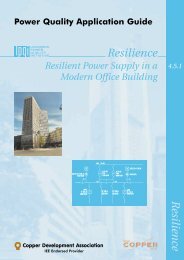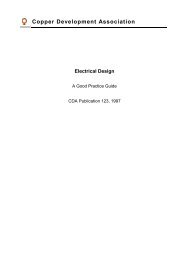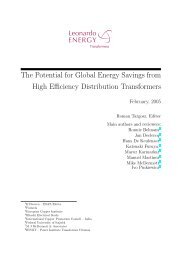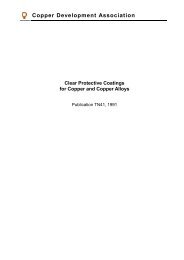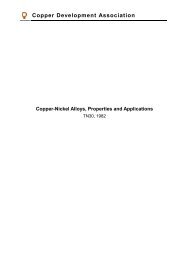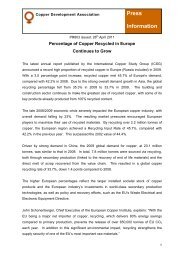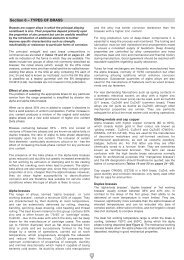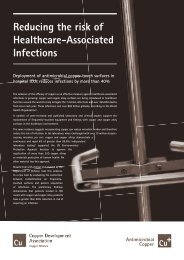Pub 118 90/10 Copper-Nickel - Copper Development Association
Pub 118 90/10 Copper-Nickel - Copper Development Association
Pub 118 90/10 Copper-Nickel - Copper Development Association
You also want an ePaper? Increase the reach of your titles
YUMPU automatically turns print PDFs into web optimized ePapers that Google loves.
<strong>Copper</strong> <strong>Development</strong> <strong>Association</strong><strong>90</strong>-<strong>10</strong> <strong>Copper</strong>-<strong>Nickel</strong>for Resistance to Corrosionand Marine BiofoulingCDA <strong>Pub</strong>lication <strong>118</strong>, 1996
<strong>90</strong>-<strong>10</strong> <strong>Copper</strong>-<strong>Nickel</strong>for Resistance to Corrosion and Marine BiofoulingCDA <strong>Pub</strong>lication <strong>118</strong>December 1996<strong>Copper</strong> <strong>Development</strong> <strong>Association</strong><strong>Copper</strong> <strong>Development</strong> <strong>Association</strong> is a non-trading organisation sponsored by the copper producers andfabricators to encourage the use of copper and copper alloys and to promote their correct and efficientapplication. Its services, which include the provision of technical advice and information, are available tothose interested in the utilisation of copper in all its aspects. The <strong>Association</strong> also provides a link betweenresearch and user industries and maintains close contact with other copper development associationsthroughout the world.Website: www.cda.org.ukEmail: helpline@copperdev.co.ukCopyright:All information in this document is the copyright of <strong>Copper</strong> <strong>Development</strong> <strong>Association</strong>Disclaimer: Whilst this document has been prepared with care, <strong>Copper</strong> <strong>Development</strong> <strong>Association</strong> can giveno warranty regarding the contents and shall not be liable for any direct, indirect or consequential lossarising out of its use
ContentsTypes of Application....................................................................................................................................2Sea Water Pipe Work ....................................................................................................................................2Offshore Fire Water Systems.........................................................................................................................3Heat Exchangers and Condensers..................................................................................................................3Sea Water Intakes ..........................................................................................................................................3Sheathing of Legs and Risers on Offshore Platforms ....................................................................................3Boat Hulls......................................................................................................................................................3Hydraulic Lines .............................................................................................................................................3Desalination Units .........................................................................................................................................3Alloy Properties ...........................................................................................................................................3Low General Corrosion Rates in Sea Water ..................................................................................................3Resistance to Stress Corrosion Cracking Due to Ammonia in Sea Water .....................................................4High Resistance to Crevice Corrosion, and Stress Corrosion due to Chlorides.............................................4Good Pitting Resistance.................................................................................................................................4Readily Weldable and No Post Weld Heat Treatment Required ...................................................................4Easy to Fabricate ...........................................................................................................................................4Sea Water Piping Systems can last a Ship’s Lifetime....................................................................................4Inherent Resistance to Biofouling..................................................................................................................5International Designations: ........................................................................................................................5Typical Mechanical Properties (Exact values with composition, size and heat treatment) .......................5Physical Properties ......................................................................................................................................5Corrosion Resistance...................................................................................................................................6Biofouling Resistance ..................................................................................................................................6Welding.........................................................................................................................................................6Relevant CDA <strong>Pub</strong>lications ........................................................................................................................61
<strong>90</strong>-<strong>10</strong> <strong>Copper</strong>-<strong>Nickel</strong>Typical Composition: <strong>10</strong>-11% Ni, 1-2% Fe, 0.5-1.0% Mn, 0.05% max. C, REM. Cu<strong>Copper</strong>-nickels have high resistance to sea water environments.The <strong>10</strong>% nickel alloy is the most widely used for sea water handling service.Types of ApplicationSea Water Pipe Work<strong>Copper</strong>-nickel is an established pipe work alloy for many of the world’s navies. It is also used inmerchant shipping, the power industry and offshore for a variety of purposes.(James Robertson Ltd)2
Offshore Fire Water SystemsSea water deluge fire extinguishing systems in copper-nickel have been selected for offshoreplatforms over many years.Heat Exchangers and CondensersGood thermal conductivity and corrosion resistance to the sea water flow rates required haveallowed copper-nickel tubing to remain an established alloy where high reliability is called for.Sea Water IntakesBuild up of fouling on intakes and intake screens can restrict water flow and if detached causeblockages to heat exchangers or cause mechanical damage to pumps and valves. <strong>Copper</strong>-nickelwith its high resistance to macrofouling can be very beneficial in this application.Sheathing of Legs and Risers on Offshore Platforms<strong>Copper</strong>-nickel is used for splash zone corrosion protection on oil/gas platform legs and riserpipes either as welded sheet or as a composite with neoprene. In an insulated form it providesantifouling properties too, which reduces wave drag and cleaning operations on the structures.More novel applications include sub-sea markers made from copper-nickel wire gauze whichremain fouling free to help divers identify submerged structural areas.Boat Hulls<strong>Copper</strong>-nickel is one of the few engineering materials with good inherent resistance to bothcorrosion and biofouling making the alloy a suitable material for boat hulls without recourse tocathodic protection or antifouling and anticorrosion paints.Hydraulic LinesWith adequate strength to withstand pressures in most marine hydraulic and instrumentationsystems, copper-nickel provides good service, combined with ease of manipulation atinstallation.Desalination UnitsConsiderable quantities of <strong>90</strong>-<strong>10</strong> copper-nickel are used in Multi-Stage Flash Desalination Unitspredominately located in the Middle East. The alloy is a prime condenser tubing material for theHeat Recovery Section and is also used for water boxes, tube plates and other fabrications assolid material or as clad steel plate.Alloy PropertiesLow General Corrosion Rates in Sea WaterGeneral corrosion rates are normally in the order of 0.0025-0.025mm/yr which makes the alloysuitable for requirements in most marine applications.3
Resistance to Stress Corrosion Cracking Due to Ammonia in Sea Water<strong>Copper</strong> based alloys can be susceptible to ammoniacal stress corrosion cracking, e.g. brass.However copper-nickel has the highest resistance to this and stress corrosion in sea water is notknown to be a problem.High Resistance to Crevice Corrosion, and Stress Corrosion due toChlorides<strong>Copper</strong>-nickel is not susceptible to the type of crevice corrosion and stress corrosion crackingfound in stainless steels. As such there is not a related temperature limitation for use in chlorideenvironments.Good Pitting ResistanceThe resistance to pitting in clean sea water is good and if pits do occur they tend to be broad andshallow in nature rather than undercut.(James Robertson Ltd)Readily Weldable and No Post Weld Heat Treatment Required<strong>Copper</strong>-nickel is straightforward to weld by conventional welding techniques. The alloy canalso be welded to steel.Easy to FabricateHot and cold working techniques can be used but because of the good ductility of the alloy, coldworking is normally preferred.Sea Water Piping Systems can last a Ship’s LifetimeExperience over the last 40 years has confirmed the durability of copper-nickel.4
Inherent Resistance to BiofoulingThe protective oxide surface film which forms naturally on copper-nickel in sea water alsoprovides an inhospitable surface to deter marine growth.The <strong>90</strong>-<strong>10</strong> alloy is only one of a family of copper-nickel alloys. 70-30 copper-nickel and a 70-30alloy with 2% manganese and 2% iron are also available where higher strength and greaterresistance to sea water velocity or sand abrasion are required. Further information is availablefrom CDA.International Designations:ASTM UNS C70600; BS CN<strong>10</strong>2; ISO CuNi<strong>10</strong>Fe1Mn W.Nr 2.0872; AFNOR CuNi<strong>10</strong>Fe1Mn;Proposed Euronorm designations: EN 12449 CuNi<strong>10</strong>Fe1Mn, CW352H.Typical Mechanical Properties(Exact values with composition, size and heat treatment)FormConditions0.1% ProofStrengthN/mm 2TensileStrengthN/mm 2Elongation percentHardnessHv <strong>10</strong>TubeAnnealed 140 320 40 85Cold drawn (hard) 460 540 13 165Temper Annealed 1<strong>90</strong>-320 360-430 30-38 115-140PlateSheetAnnealed 120 320 42 85Hot Rolled 140-1<strong>90</strong> 340-360 40 95-<strong>10</strong>5Annealed 120 320 42 85Cold Rolled 380 420 12 125Physical PropertiesDensity: 8.9g/cm 3Melting point: 1<strong>10</strong>0-1145 o CPermeability:
Corrosion Resistance<strong>90</strong>-<strong>10</strong> copper-nickel lies mid way in the galvanic series and is compatible with other copperalloys. It is less noble than stainless steels and high nickel alloys and more noble than steel,aluminium and zinc.With low general corrosion rates and good resistance to localised corrosion the alloy showsexcellent performance under many sea water conditions.In continuous flowing sea water experience has shown that <strong>90</strong>-<strong>10</strong> copper-nickel behaves wellfor condensers and heat exchangers with water velocities up to 2.5m/s. For pipeline systemsvelocities are permitted up to 3.5m/s for larger diameter pipes. Note, under intermittent flow,typical of fire mains, copper-nickel can tolerate short periods of high water velocities up to 5-<strong>10</strong>times the normal pipework maximum. The hydrodynamics around a boat hull allow highervelocities than in a pipe; a 24knot (12m/s) vessel over 14 months service experienced noimpingement attack on hull panels.<strong>90</strong>-<strong>10</strong> copper-nickel also has good resistance to a wide range of other environments includingdilute reducing acids and caustic, dry gases, brine and brackish water. The alloy is not advisedfor polluted water as sulphides can cause pitting and higher corrosion rates. Solutions ofammonia also lead to higher corrosion rates.Biofouling ResistanceThe alloy possesses a high inherent resistance to macrofouling which is similar to copper itself.Best resistance to macrofouling is achieved when the alloy is freely exposed and notcathodically or other wise galvanically protected.WeldingWhen welding the alloy itself, the 70-30 copper-nickel weld consumable is preferred as itproduces a sound weld and is slightly more noble than the base metal. For welding the alloy tosteel, a 65% nickel-copper consumable is recommended.Relevant CDA <strong>Pub</strong>licationsTN30 <strong>Copper</strong>-<strong>Nickel</strong> Alloys - Properties and Applications.TN31 <strong>Copper</strong>-<strong>Nickel</strong> <strong>90</strong>/<strong>10</strong> and 70/30 Alloys - Technical Data.Preventing Biofouling with <strong>Copper</strong> Alloys - CDA <strong>Pub</strong>lication 113.Joining of <strong>Copper</strong> and <strong>Copper</strong> Alloys - CDA <strong>Pub</strong>lication 98.CDA Datadisk ‘<strong>Copper</strong>-<strong>Nickel</strong> Alloys and Aluminium Bronze Alloys’.6
<strong>Copper</strong> <strong>Development</strong> <strong>Association</strong>5 Grovelands Business CentreBoundary WayHemel HempsteadHP2 7TEWebsite: www.cda.org.ukEmail: helpline@copperdev.co.uk




